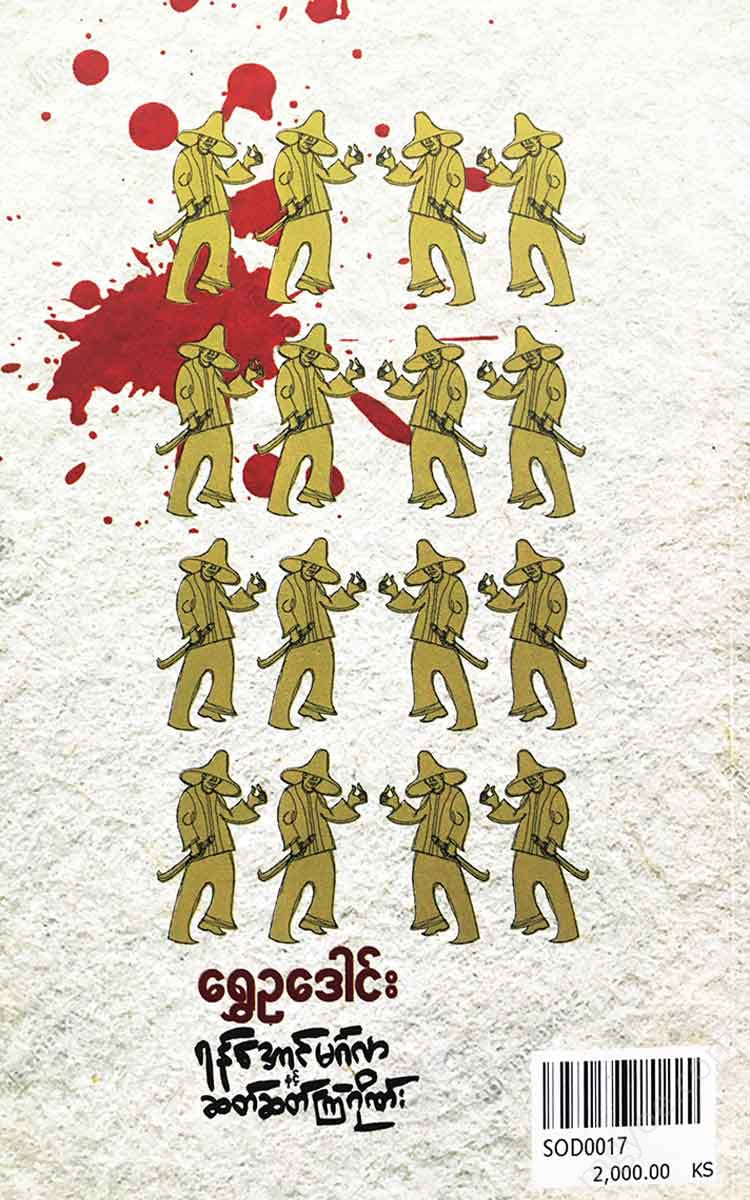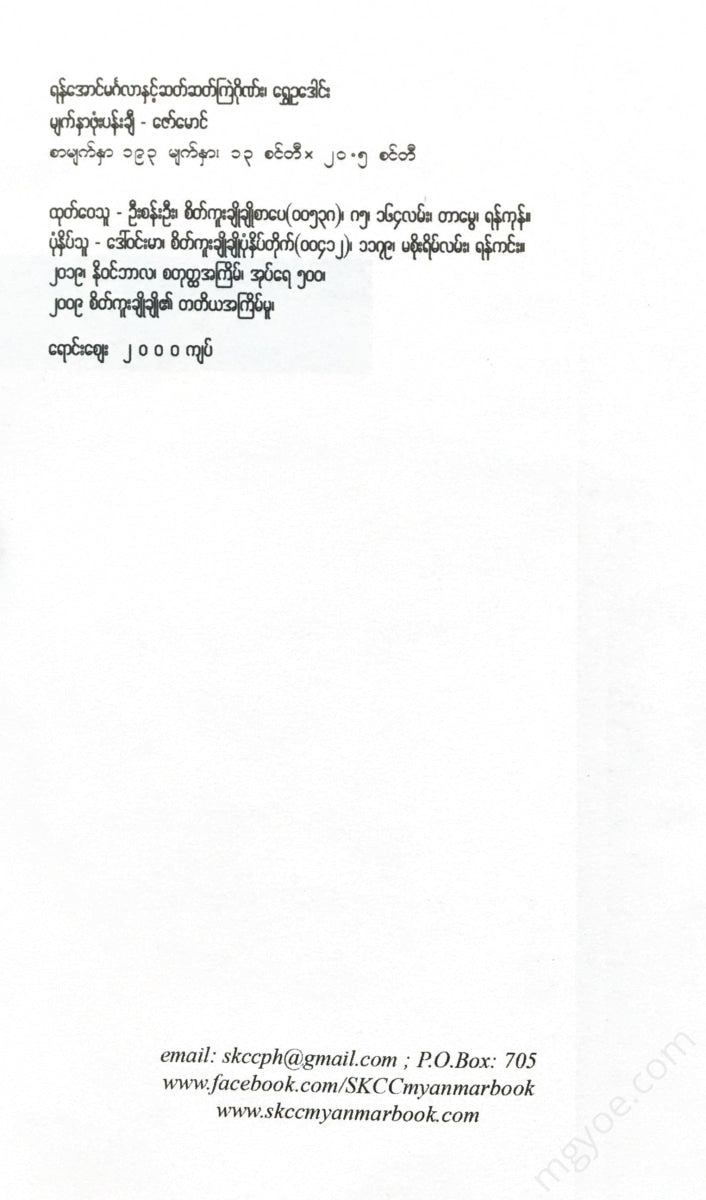စိတ်ကူးချိုချိုစာပေ
Golden Peacock - Yan Aung Mingalar and the Sasat Kyae Gang
Golden Peacock - Yan Aung Mingalar and the Sasat Kyae Gang
Couldn't load pickup availability
Three packs of paper
Last year, while I was staying at Mingun Chaung in the Sagaing Hills with my teacher, Mr. Maung Maw, on a pilgrimage, a man wearing a long-sleeved shirt, white linen, a rosary and a large, beautiful robe, who was an old acquaintance of my teacher, often visited me. Mr. Maung Maw told me that I was the author of the Rupanandi Vutthu, and the man said that he had read the novel and that it had something to do with his work, and that he liked it very much. He greeted me with joy. The man was about 50 years old and was a monk, and his name was U Taet Htun.
I don't have much faith in the work of mining, but since mining experts often encounter strange and surprising events, whenever I met this man, I would ask him about his work, and he would tell me about it with great enthusiasm. Some of the events he told me were hard to believe, but I must admit that they were truly strange and surprising.
After a month of fasting, I returned to Yangon with the monk Mr. Maung Ming. About three months later, Mr. Maung Ming visited my home. The monk gave me a letter and a parcel, which were from the monk U Taek Htun. I first read the letter and found the following:
Please write, teacher.
I believe that you are the author of the Rupanandi Vutthu and a person who can create and write strange and wonderful stories. I have sent you this parcel to use as you wish. If you read the events written in the parcel with the teacher, and if you think that the people should know about it, you can use it as you wish. However, I will first tell you how these four texts came into my hands.
When I met you at Mingun Chaung about three months ago, I was on a sabbatical because I had a plan to dig up the Yan Aung Mingalar deposit. The instructions on the deposit said that anyone who had a plan to dig according to the deposit must observe a sabbatical for exactly three months. So after you returned, I observed a sabbatical at Mingun Chaung for more than a month, and then I and a disciple left for Tagaung, where the Yan Aung Mingalar deposit is located.
As you know, Tagaung is one of the oldest cities in Myanmar, as it is called (from the Burmese word Tagaung). No matter how great this city was in ancient times, it has now become a small village, since the city walls have recently been demolished. However, as is typical of old cities, there are many old moats, old pagodas, and old temples.
The Yan Aung Mingalar deposit is to be excavated from the site where the Myo Daung Pagoda used to be. I arrived in Tagaung with a disciple and stayed at the home of an old man friend. If the deposit is true, there will be no need to dig too much, and the head of the tunnel will be found with just a little digging, without letting the other villagers know, so the host old man and I, the teacher and disciple, will be enough.
After arriving in Tagaung, the three of us searched for the Myotan Pagoda, which is located in the southeast corner of the old city. The old moat is still intact, so we can easily find the place where the Myotan Pagoda used to stand. The pagoda, however, is no longer there. A thick bush has grown where the pagoda used to be. The fact that it is covered with such thick bushes is very convenient for our plan. The reason is that the place is not far from the city, and if it were open and free of bushes, others would certainly see our excavation. But now that it is covered with bushes, our group can easily go into the bushes and dig without anyone seeing.
The three of us swore an oath not to hide the things we found and to share them equally. Then, on a good day, we entered the cave at noon on the day of the Kartika Nakshatra. Even though we dug a little in the cave, we found some broken bricks, so we were satisfied that this was the site of the city corner pagoda. When we had dug about three cubits, we found a large iron ring, as mentioned in the inscription. The iron ring was an iron ring attached to a large stone mat, and the stone mat was about two cubits in diameter.
The three of us dug out the soil covered in the stone mat, then dug a hole in the iron ring and lifted the stone mat. At first, we couldn't lift it, so we used a hammer to pry out the soil on the sides, then turned the edge of the stone mat from all four sides and pry it open with a hammer. Then the three of us used a hammer to pry open the iron ring and lifted the hammer, and the stone mat also opened up.
When the rock opened up and a hole about two cubits wide appeared, we saw the stairs leading down. Then we looked down with the flashlight we had brought with us, and the stairs did not go straight down but turned to the side, so we could not see beyond about ten steps.
I went down the stairs with a flashlight, and the student and the old man followed. When we went down about ten steps, the stairs turned to the right, so we followed the boat steps. When we went down about ten steps, they turned to the right again.
Then, they could no longer see the entrance, and as soon as they turned off the flashlight, they saw that it was completely dark. After going down three times in a clockwise direction, they finally arrived at a large hall about ten cubits in circumference. The hall was square, and on one wall, at about the waist of a man, they saw a stone slab about a cubit in circumference.
There were letters written on the stone, and as I pressed one of the letters with my hand, as described in the inscription, I heard a long, loud sound like the neighing of a horse. The neighing of a horse is not a terrifying sound when heard on the ground, but when I went down with the intention of digging up the things that the ancients had hidden, and heard it in the tunnel, my heart sank and I was so shocked that I could hardly stand it.
As soon as the sound stopped, the stone mat suddenly opened as if someone had pulled it from inside. We had to continue to enter through the opening, but my disciple was brave and confident, but the old man refused, saying he did not dare to follow. According to the instructions, everyone who entered the cave had to enter through that opening, and no one was allowed to stay behind. The instructions were very strict, so it was very important to follow them exactly. So I had to coax the old man with a few twists and turns.
When we each entered through a hole that was about a cubit wide, we found a very narrow tunnel, only about two cubits wide. After walking along the tunnel for about 15 cubits, there was a large bronze head on a brick platform. The head was about 4 cubits long, so if it was a head made for burial, I thought that it must have been the body of a very large and stout man. We had to open the head. The old man was so scared that he could not do anything to help, so only the two of us, the teacher and the disciples, had to open the head. The bronze head was closed with six bolts on the top, and when we cut the bolts, we heard a loud groaning sound as if we were in severe pain.
But our two disciples, without fear, continued to open it. As we opened it, the groaning sound grew louder and louder, and it was impossible to tell whether it was coming from above, below, in front, behind, or inside the head. The old man was so frightened that he could not help but beg not to open the big head. However, we could not agree to give in after having tried so hard.
We removed the bolts one by one, and finally, when we had removed six bolts, we lifted the head cover.
As soon as the lid was opened, the moaning sound suddenly stopped and a loud, loud laugh came out. The laugh was even more terrifying than the moaning sound.
The old man, however, was lying face down on the ground, unable to look into his head.
Inside the head, there are five royal ornaments, and the person wearing them is a skeleton. One unique feature of this skeleton is that the head and the entire body are not turned on their backs, but are tilted to the side.
Based on this, the body appeared to have come to life after being placed in the skull. When we read the inscriptions inside the parcel, we will find that this idea is correct. Our teacher and disciple took out the royal ornaments and removed the bones, and searched the skull carefully. As we expected, we did not find the stones and rubies, but only the three envelopes of inscriptions. I cannot think whether the gold and silver mentioned in the deposit list disappeared because of the old man's mistake, or whether the deposit list itself was lost. The old man was right. Because the person who was looking for the property, no matter how much he was afraid, should not be afraid or tremble, and the old man made the mistake because he was so afraid.
But we are not in vain. The three rubies in the royal robes are enough to cover all expenses and to live comfortably. So we took the royal robes and the three bundles of food, put the bones back in the skull, closed the skull again, and brought out the old man with us.
When we reached home, I read the manuscripts and found that they contained many strange and surprising events about Burmese history that many people do not know. After reading the manuscripts, I remembered the author of the novel Rupanandi and thought that I should use them according to his wishes. So I wrapped the four manuscripts in a parcel and sent them to Mr. Maung Ming with the message that I would give them to him as a favor. After using them, I thought it would be appropriate to send them to the Secretary of the Treasury.
Maung Taek Htun
After reading the above strange letter, Mr. Maung Ming and I continued to read the scriptures and found many strange events. The four events are truly mysterious events, and since they are old texts, they are written in ancient Burmese. I asked Sayar Ming about any words I did not understand, and with his help, I rewrote them in modern Burmese so that people could understand them. The four scriptures are individually wrapped, so the events in them also seem to be separate chapters.





